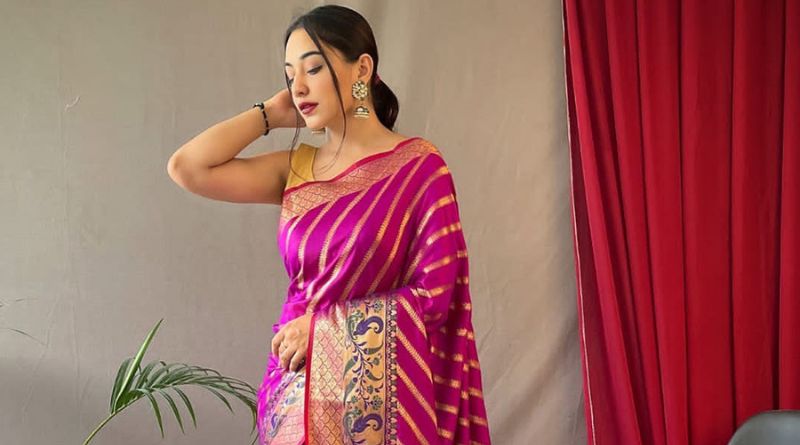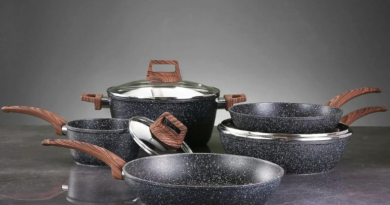Welcome to the realm of elegance and tradition as we usher in Makar Sankranti-Pongal 2024. This blog unfolds a tapestry of timeless beauty, guiding you through the allure of Kanjivaram to Banarasi sarees, offering insights into the top choices for your festive wardrobe. As the harvest festivals draw near, we delve into the cultural significance of these celebrations and how the choice of sarees becomes an integral part of the festivities. Join us on a journey that explores the craftsmanship, colors, and stories woven into each thread of these exquisite sarees. Discover the top recommendations, ensuring you step into the celebrations adorned in the finest attire, blending the richness of tradition with the spirit of Makar Sankranti-Pongal 2024.
Kanjivaram to Banarasi saree to buy
Discover the elegance of Makar Sankranti-Pongal 2024 fashion with our blog. From Kanjivaram to Banarasi sarees, explore and shop for timeless traditions!
Kanjivaram Silk Saree
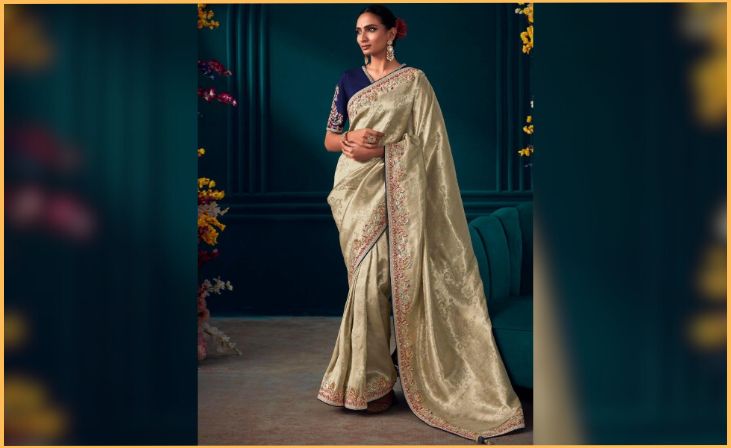
The Kanjivaram Silk Saree, originating from the town of Kanchipuram in Tamil Nadu, is a masterpiece that epitomizes the richness of South Indian tradition. Crafted with meticulous attention to detail, these sarees are woven from pure silk and adorned with intricate zari work, showcasing a brilliant interplay of vibrant colors. The hallmark of a Kanjivaram saree lies in its luxurious texture and the elaborate motifs that narrate tales of heritage and culture. Often featuring traditional elements like peacocks, elephants, and temple borders, each Kanjivaram saree is a testament to the skillful craftsmanship passed down through generations. Renowned for their opulence, these sarees are a preferred choice for grand celebrations and weddings, reflecting not just elegance, but also the cultural richness of South India. Wearing a Kanjivaram Silk Saree is not merely a sartorial choice; it’s an embrace of tradition and an adornment of timeless beauty.
Also Read- 7 Fashionable and Daring Outfits Worn by Sonam Bajwa
Banarasi Brocade Saree
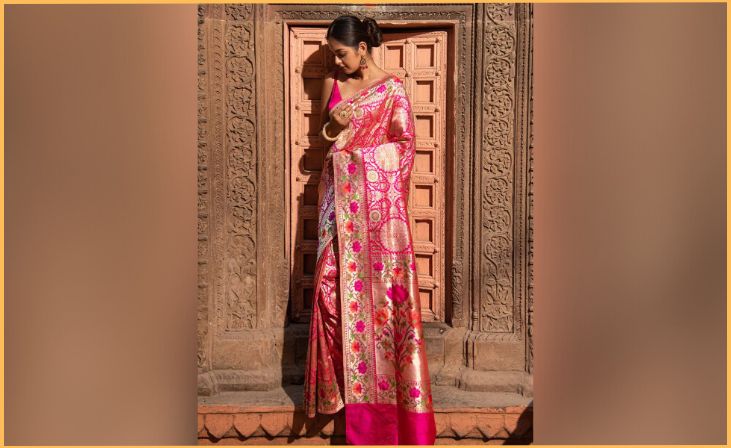
The Banarasi Brocade Saree, hailing from the holy city of Varanasi, is a symbol of timeless elegance and intricate craftsmanship. Woven with fine silk, these sarees are distinguished by their elaborate brocade work, featuring mesmerizing patterns created with gold or silver zari threads. The luxurious texture and the opulent sheen of a Banarasi brocade saree make it a cherished choice for special occasions and celebrations. What sets these sarees apart is the meticulous detailing, often showcasing motifs inspired by Mughal artistry, creating a regal and sophisticated aura. Whether adorned with floral patterns, peacock motifs, or intricate geometric designs, each Banarasi brocade saree narrates a story of cultural heritage and artistic finesse. Draping oneself in the richness of a Banarasi brocade saree is not just a fashion statement; it’s an homage to centuries-old craftsmanship and a celebration of unparalleled beauty.
Paithani Silk Saree
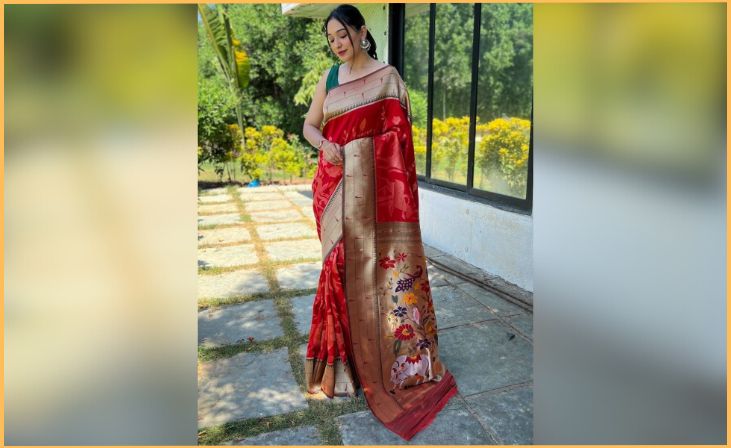
The Paithani Silk Saree, hailing from Maharashtra, is a piece of cultural heritage that encapsulates the essence of traditional craftsmanship. Renowned for its rich silk fabric and vibrant hues, the Paithani saree is distinguished by its peacock and flower motifs, meticulously woven with multicolored silk and zari threads. The distinctive feature of a Paithani saree is its vibrant pallu, a riot of colors adorned with intricate designs that represent the glorious tapestry of Indian culture. The lightweight yet opulent texture makes it an ideal choice for festive occasions and celebrations. Each Paithani saree is a work of art, a reflection of Maharashtra’s artistic legacy, and wearing one is not just donning attire; it’s embracing a piece of history and expressing an appreciation for the exquisite artistry that defines Indian textiles.
Chanderi Cotton Saree
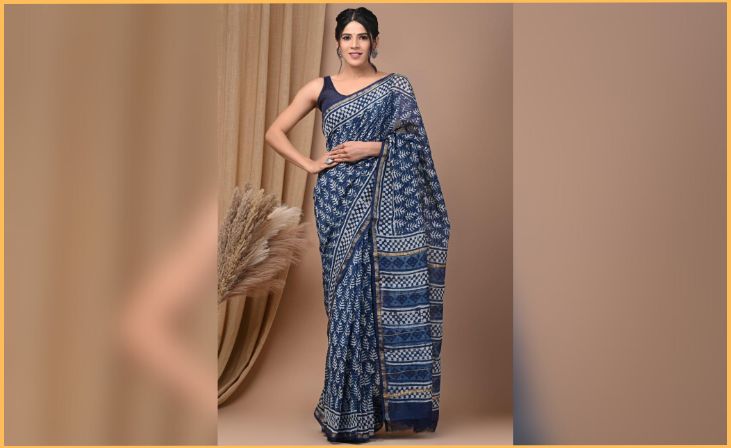
The Chanderi Cotton Saree is a testament to the delicate craftsmanship and sheer elegance that originates from the town of Chanderi in Madhya Pradesh, India. Woven with a blend of silk and cotton, these sarees are celebrated for their lightweight and airy texture, making them an ideal choice for daytime festivities. The hallmark of a Chanderi Cotton Saree lies in its fine zari work and intricately woven patterns that often include traditional motifs like peacocks and florals. The sheer transparency of the fabric, known as “kora” in local parlance, adds a subtle allure, making it a graceful option for both casual and formal events. The blend of comfort, sophistication, and the timeless charm of Indian motifs makes the Chanderi Cotton Saree a must-have in any discerning wardrobe, seamlessly blending tradition with contemporary style.
Kota Doria Saree
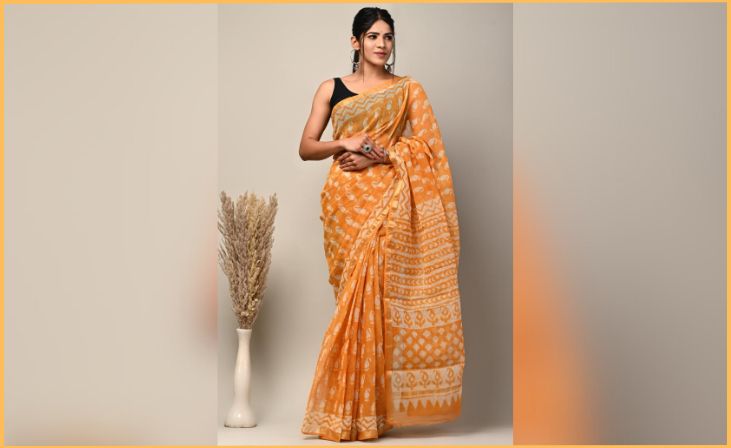
The Kota Doria Saree, originating from the town of Kota in Rajasthan, India, is a splendid manifestation of fine weaving and delicate craftsmanship. Crafted with a unique blend of cotton and silk, these sarees are celebrated for their lightweight and sheer texture. What sets the Kota Doria Saree apart is its distinctive square-shaped patterns, known as “khats,” and the traditional gold or silver border, adding an element of grace and sophistication. The open weave of the fabric not only ensures comfort in warmer climates but also provides a canvas for intricate floral or geometric designs. Whether adorned with block prints or vibrant dyeing techniques, each Kota Doria Saree tells a story of Rajasthan’s rich textile heritage. Donning a Kota Doria Saree is not merely a fashion choice; it’s a celebration of the timeless artistry that defines Indian handloom traditions.
Bandhani Tie and Dye Saree
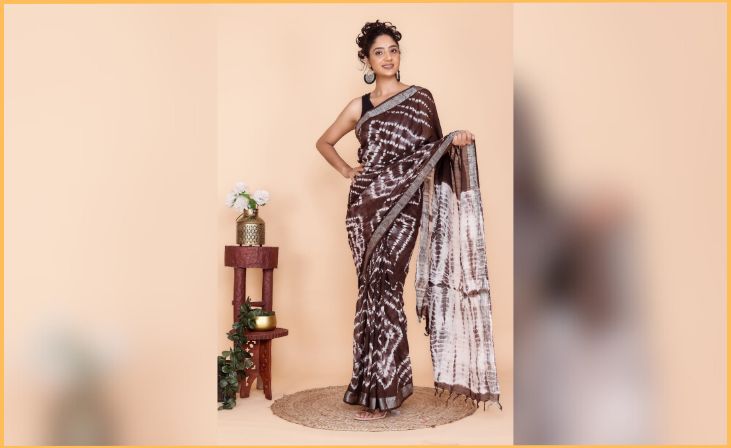
The Bandhani Tie and Dye Saree is a vibrant and intricately crafted piece that originates from the rich textile heritage of Gujarat and Rajasthan, India. Characterized by small, vividly colored dots created through the tie and dye technique, these sarees are a visual spectacle, representing the skillful artistry of local artisans. The process involves tying small portions of the fabric with thread before dyeing, resulting in a myriad of eye-catching patterns. The vibrant hues and intricate designs make Bandhani sarees a popular choice for festive occasions, weddings, and celebrations. Each dot tells a story, and the meticulous craftsmanship exemplifies the cultural richness and traditional techniques passed down through generations. Wearing a Bandhani Tie and Dye Saree is not just embracing a colorful attire; it’s celebrating the vibrant spirit and artistic legacy deeply rooted in the heart of India.
Patola Silk Saree
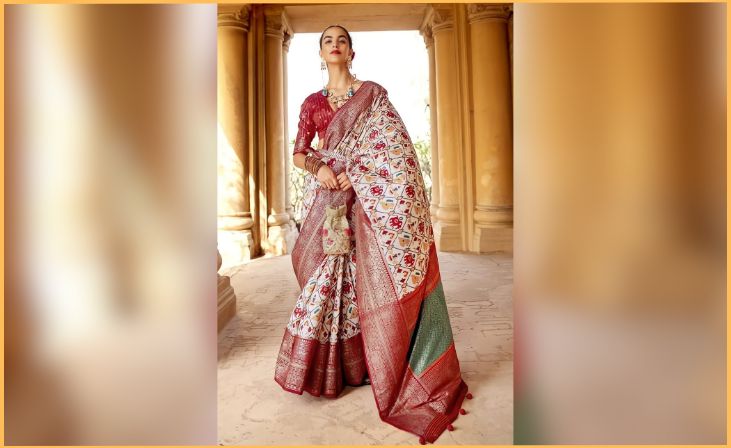
The Patola Silk Saree is a masterpiece of silk weaving that finds its roots in the culturally rich state of Gujarat, India. Renowned for its intricate geometric patterns and vibrant colors, the Patola saree is a testament to the meticulous craftsmanship of skilled artisans. What sets it apart is the double ikat weaving technique, where both the warp and weft threads are resist-dyed before weaving, creating symmetrical designs on both sides of the fabric. These sarees often feature elaborate motifs inspired by nature, temple architecture, and traditional geometric shapes. The Patola Silk Saree is not merely an attire; it is a symbol of cultural pride and a reflection of the artistic legacy passed down through generations. Donning a Patola Silk Saree is an ode to the timeless artistry that defines the rich tapestry of Indian handloom traditions.
Tussar Silk Saree

The Tussar Silk Saree, originating from the silk-producing regions of India, such as Bihar, Jharkhand, and West Bengal, is a testimony to natural elegance and simplicity. Crafted from the silk of the Tussar silkworm, these sarees are known for their rich texture, earthy tones, and a unique, coarse surface. The beauty of Tussar silk lies in its natural golden sheen and lightweight feel. The sarees often feature minimalistic designs, allowing the purity of the fabric to shine through. Whether adorned with simple borders or intricate hand-embroidery, Tussar Silk Sarees exude a subtle charm, making them perfect for both casual and formal occasions. The Tussar Silk Saree is not just a garment; it’s a celebration of nature’s beauty, reflecting the essence of simplicity and sophistication in Indian handloom traditions.
For More- 9 Most stylish looks of Tamannaah Bhatia
Conclusion
As we conclude our exploration into the world of Makar Sankranti-Pongal 2024 fashion, the journey from Kanjivaram to Banarasi sarees has unfolded a tapestry of timeless elegance. These traditional attires not only reflect the grandeur of Indian craftsmanship but also embody the cultural richness and stories woven into each thread. Choosing between the opulence of Kanjivaram and the intricate brocade work of Banarasi is a celebration of individual style amidst the festive fervor. As you prepare to embrace the joyous occasions, let the drapes of these exquisite sarees amplify the spirit of Makar Sankranti-Pongal, marking the transition to warmer days with grace and tradition.
FAQs
Reputed saree boutiques, handloom stores, and online platforms specializing in traditional attire are ideal places to find authentic Kanjivaram and Banarasi sarees.
Yes, both Kanjivaram and Banarasi sarees offer a versatile range, and lighter hues or subtle designs make them suitable for daytime festivities during Makar Sankranti-Pongal.
Traditional jewelry like temple jewelry, jhumkas, and intricate bangles pair well with Kanjivaram and Banarasi sarees. Choose accessories that complement the richness of the saree.

